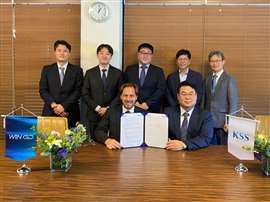WinGD, shipping company explore ammonia-fueled carriers
20 September 2023
Focus is on 52 cm- and 62 cm-bore versions of the dual-fuel ammonia engines
WinGD said it will collaborate with South Korea’s KSS Line to explore ammonia-fueled gas carriers.
The companies said they will focus on 52 cm- and 62 cm-bore versions of the dual-fuel ammonia engines, suitable for midsize and very large gas carriers (VLGC). The agreement is the latest of several collaborations under which WinGD is working with experts from across key shipbuilding locations and vessel segments to develop its ammonia capabilities.
The scope of the cooperation will extend beyond engine technology, also focusing on the performance and maintenance solutions necessary for using alternative fuel. The partners will also explore how deep insights into the engine performance can be provided through the deployment of WinGD’s Integrated Digital Expert (WiDE), enabling fuel efficiency fine-tuning and live support from engine experts.
 Front (L-R): Carmelo Cartalemi (WinGD, General Manager Global Sales), Chando Park (KSS Line, CEO). (Image: WinGD)
Front (L-R): Carmelo Cartalemi (WinGD, General Manager Global Sales), Chando Park (KSS Line, CEO). (Image: WinGD)
The agreement also includes a commitment from WinGD to deliver crew training for new engines. The company is building significant experience in equipping crew for safe and reliable ammonia-fuelled engine operations, having agreed in June to develop and support the implementation of a training syllabus for AET Tankers and maritime academy Akademi Laut Malaysia.
“Ammonia as fuel is an interesting prospect for gas carrier vessels that already carry ammonia as cargo,” said Volkmar Galke, director Sales, WinGD. “The combination of our rigorously tested new engine design, training support and real-time optimisation via WiDE will mean that KSS Line can be confident that early experience with ammonia-fuelled vessels will be translated into safe and reliable operation in the long-term.”
Chando Park, CEO, KSS Line said the company aims to decarbonize its fleet rapidly and has already made significant investments in smart ships, LPG-fuelled and methanol-fuelled technology.
“Exploring ammonia as a fuel is the next step,” Park said. “The project with WinGD gives us the technical support we will need to successfully apply this new fuel type to our forthcoming newbuilds.”
WinGD is due to begin validation of its ammonia-fuelled engine concept on single and multi-cylinder test engines, in Winterthur and Shanghai, later this year. The validation tests follow combustion concept testing that began in 2021, in concert with simulation and rig tests to understand the emissions characteristics and injection requirements of ammonia fuel.
The X-DF-A engine, like its methanol-fuelled counterpart X-DF-M, will operate on a high-pressure Diesel-cycle combustion process, with liquid ammonia fuel injection supported with a low portion of pilot fuel.
STAY CONNECTED




Receive the information you need when you need it through our world-leading magazines, newsletters and daily briefings.
POWER SOURCING GUIDE
The trusted reference and buyer’s guide for 83 years
The original “desktop search engine,” guiding nearly 10,000 users in more than 90 countries it is the primary reference for specifications and details on all the components that go into engine systems.
Visit Now
CONNECT WITH THE TEAM










